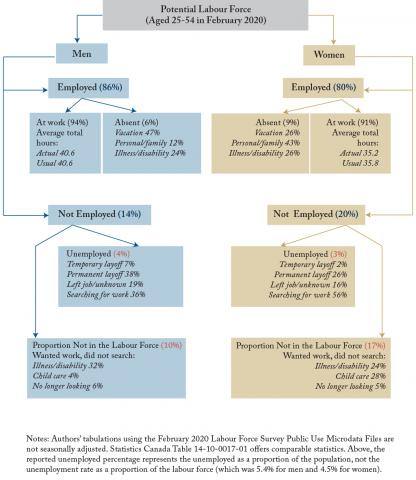From: Kevin Milligan and Tammy Schirle
To: Bill Morneau, Minister of Finance
Date: April 8, 2020
Re: A Labour Force Survey pandemic primer
Tomorrow’s Labour Force Survey (LFS), covering March 2020, will provide the first official statistical look into the impact of COVID-19 on the Canadian labour market.
It will be an incomplete snapshot, because its reference week, Sunday March 15 to Saturday March 21, came in the midst of the pandemic’s disruption. But the numbers for employment and hours will still provide valuable insights, unlike the usual headline unemployment measure. Here’s why:
- Timing: the LFS was in the field just as COVID-19 started to change the economy.
- Categories: COVID-19 work patterns challenge the normal categorization of work.
- Hours: the distinction between ‘actual’ and ‘usual’ hours becomes critical.
First, the survey’s reference week was one of transition into shutdowns. For Ontario, that week normally should have been a quiet March Break, with a few extra vacations and kids in day camps while parents worked. Instead, the week was preceded by announcements of public-school shutdowns (March 12), followed by an expansion of job-protected leaves (March 16), required closures of childcare centres, restaurants, libraries, events and more (March 17), and a general push to work from home when possible. Since then, governments across Canada have enforced even more restrictive measures to protect public health, which means the full adjustment to COVID-19 is not captured.
Second, the crisis will lead to large shifts across the standard LFS labour market activity categories of employed, unemployed and non-participants. To understand why requires a deeper dive into the category definitions.
What does it mean to be employed? The survey begins by asking people if, during the reference week, they worked at a job or business. If ‘yes,’ they are labelled as employed and at work. Seems simple enough, but it’s not clear all people who were sent home because of COVID-19 would report working at their job, especially if working from home is new to them. If they said ‘no’ to being employed they are asked if they have a job but were absent. If absent, the respondent is recorded as employed but absent. Respondents are asked about their reasons for absence, whereby men most often report vacations and women most often report personal or family reasons. Taken together, the clearest picture of the impact of COVID-19 will come from the change in the ‘employed and at work’ category.
But what if someone reports they didn’t have a job? These respondents are placed into the category of ‘unemployed’ or ‘not in the labour force’ based on the reasons for not having a job. A person is unemployed if they are available for work and report they have been temporarily laid off due to business conditions, have a job to start within four weeks, or had searched for work in the previous four weeks (including the reference week). With COVID-19 closures, most parents with full time childcare responsibilities would not be considered available for work, and few will be actively searching for work. For many people, it might not be clear whether a layoff is ‘temporary.’ For others, plans to start a new job in the near future will suddenly appear unlikely. For these reasons, many who might normally be considered ‘unemployed’ may not be for the March 2020 LFS.
Instead, many of those without a job because of COVID-19 may be categorized as non-participants in the labour force. The non-searchers who enter this category, but wanted work, are asked why they did not search for work. Normally, the most common reasons are one’s own illness or disability and (for women) caring for children. These reasons may grow substantially in March 2020. The belief that no work is available – which is normally used to indicate discouraged workers – will also grow in importance in the COVID-19 context. For these reasons, we expect a large shift from employment straight to non-participation, without first passing through the technical state of ‘unemployment.’
The third key to understanding the March 2020 LFS is the distinction between usual and actual hours. Everyone who is employed is asked about the usual hours of work; those employed and at work also report their actual hours. For men, there is almost no difference between actual hours of work and usual hours. For women, there is normally a small difference, which in part reflects gendered caregiving responsibilities.
For the March 2020 LFS, the difference between actual and usual hours of work will reveal lost hours associated with COVID-related measures, reflecting a combination of mid-week layoffs, reduced hours associated with working at home, and reduced hours available with many employers. Of course, there are many industries and occupations that may increase hours. Grocery stores and front-line healthcare staff are examples. Overall, a focus on actual hours will be paramount.
Tomorrow’s LFS will provide a partial revelation of the tumult the crisis has wrought upon the Canadian labour market. The worst is yet to be revealed. But focusing on movements in ‘employed at work’ and ‘actual hours worked’ will provide the surest indications of how the work of Canadians is responding to COVID-19.
Kevin Milligan is professor of economics, UBC Vancouver School of Economics, and a Fellow-in-Residence at the C.D. Howe Institute and Tammy Schirle is Professor of Economics at Wilfrid Laurier University, and is a C.D. Howe Institute Research Fellow.
To send a comment or leave feedback, click here.
The views expressed here are those of the authors. The C.D. Howe Institute does not take corporate positions on policy matters.






